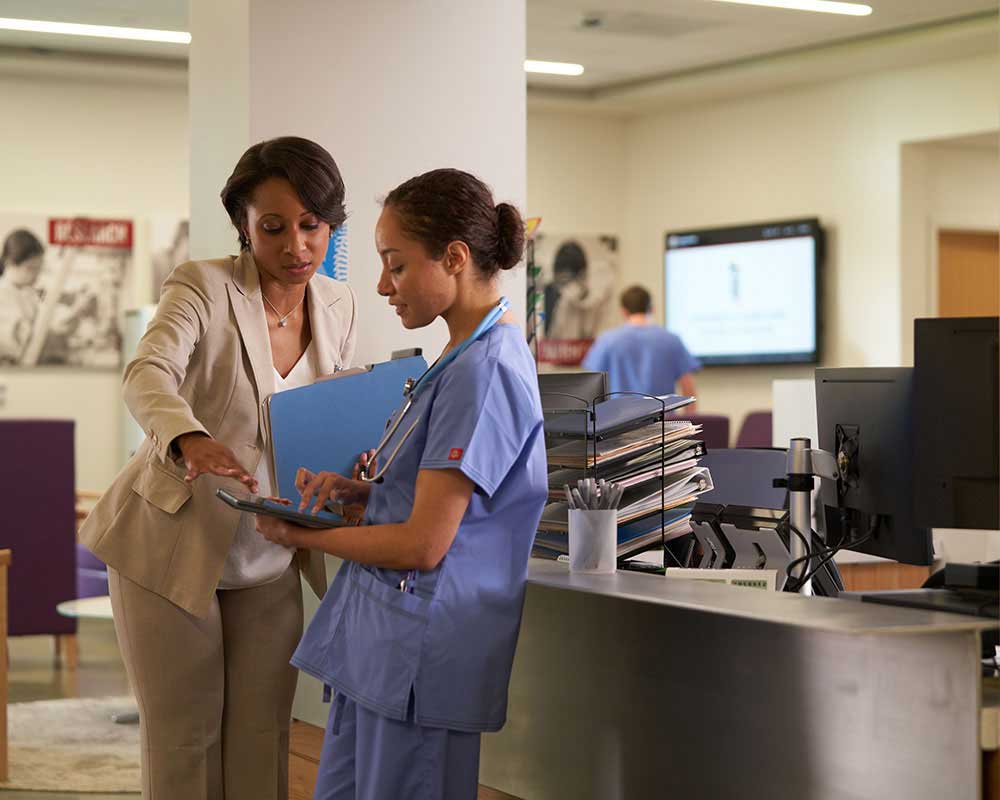A Full Overview to Medical Administration Certifications and Accreditations
A Full Overview to Medical Administration Certifications and Accreditations
Blog Article
Innovations in Medical Management: Exactly How Technology Is Reshaping Healthcare Monitoring
The landscape of health care management is undertaking an extensive improvement, driven by technological innovations in clinical administration. Electronic Wellness Records (EHR) have ended up being the foundation of reliable client information administration, while telemedicine bridges distances, making health care available to even one of the most remote locations. Artificial knowledge is not just an advanced concept yet a present-day tool that individualizes individual treatment and improves management tasks. As these technologies take spotlight, an essential concern arises: exactly how will these technologies additionally redefine the healthcare experience for both carriers and clients in the coming years?
Development of Electronic Wellness Records
Over the previous few decades, the development of digital health records (EHRs) has actually dramatically changed the landscape of medical administration. Created to digitize person records, EHRs have expanded beyond their original scope to become integral devices in simplifying medical care procedures, boosting person treatment, and boosting management performances. The shift from paper-based systems to EHRs has actually decreased redundancies, reduced errors, and assisted in seamless information sharing throughout various health care carriers, therefore allowing extensive and worked with individual care.
EHRs have presented a paradigm change in health care management by incorporating scientific, administrative, and economic information, thus enabling even more informed decision-making. The accessibility of real-time person data encourages health care professionals to make prompt diagnostic and therapy decisions, further improving patient end results. EHRs support the application of evidence-based practices by supplying access to the most current medical research study and treatment guidelines straight within the clinical operations.
The federal motivations and regulations have actually accelerated EHR adoption, making certain compliance with requirements that safeguard client personal privacy and data safety. As the medical care market continues to accept electronic change, EHRs continue to be at the forefront of technology, driving efficiency and boosting the overall quality of health care distribution.
Improvements in Telemedicine
Telemedicine has swiftly advanced recently, basically altering the method health care solutions are provided. This transformation is mainly attributed to technological innovations that have broadened accessibility to healthcare, particularly for individuals in remote or underserved locations. Telemedicine platforms help with real-time appointments between patients and doctor, thus minimizing the demand for in-person brows through and considerably reducing delay times.
The assimilation of video clip conferencing, mobile health applications, and remote tracking tools has actually enhanced the scope of telemedicine. Patients can now manage persistent conditions with continuous tracking, get timely assessments, and gain access to expert care without geographical constraints. This change has not just better patient contentment yet has actually likewise maximized medical care operations and resource allotment.
Furthermore, telemedicine has played a crucial role in public health, specifically throughout pandemics, by reducing the risk of transmittable condition transmission. Regulative developments have further sustained telemedicine's expansion, with numerous countries changing policies to enable more comprehensive insurance protection for virtual sees.
In spite of challenges such as electronic literacy and data protection, the recurring development of telemedicine guarantees to maintain its trajectory as a keystone of contemporary health care management, using a much more obtainable and effective medical care delivery model.
Expert System in Healthcare
Structure on the technical advancements seen in telemedicine, synthetic intelligence (AI) is rapidly becoming a transformative force in medical care management. One of the most engaging applications of AI in medical care is anticipating analytics, which makes it possible for medical care managers to prepare for individual demands, enhance source allowance, and enhance individual results.

An additional noteworthy application remains in customized medication, where AI assists in customizing treatments to specific client profiles by assessing genetic, way of living, and environmental variables (medical administration). As AI continues to advance, its combination right into health care management promises to enhance procedures, minimize prices, and eventually read more boost the quality of treatment provided
Enhancing Data Protection Measures
As health care organizations progressively count on electronic systems for taking care of person information, the requirement for robust data safety and security steps has grown greatly. Information violations not only jeopardize patient privacy yet additionally lead to considerable monetary losses and damage to institutional reputations.
Healthcare establishments are executing multi-layered security structures to mitigate dangers. Encryption modern technologies guarantee that delicate data continues to be inaccessible to unapproved users, both throughout transmission and storage. The fostering of blockchain technology offers a promising opportunity for boosting data stability and traceability, giving an immutable record of all purchases.

Educating team on cybersecurity best methods is similarly crucial. Awareness programs gear up health care workers with the expertise to identify and report possible threats, such as phishing attempts. By prioritizing data protection, clinical administrations can safeguard client info and preserve depend on.
Improving Person Interaction Equipment
While durable information security steps are fundamental in securing client info, equally important is the improvement of person interaction systems to make certain reliable healthcare delivery. In the evolving landscape of medical care monitoring, technical advancements are playing a crucial role in changing just how health care companies communicate with patients. Reliable interaction systems not only improve person contentment yet likewise enhance professional end results by making sure timely and exact info exchange.
One of the substantial improvements in this area is the assimilation of electronic health documents (EHR) with patient sites. This integration permits people to access their medical details safely, timetable visits, and communicate with doctor successfully. Furthermore, the usage of telemedicine platforms has actually expanded accessibility to healthcare services, specifically for those in you can try this out remote areas or with flexibility difficulties. These systems help with real-time appointments, decreasing the demand for physical gos to and making it possible for continuous treatment monitoring.
Moreover, man-made intelligence-powered chatbots are being increasingly employed to give instantaneous useful source feedbacks to client questions, using a seamless communication experience. By leveraging these technological advancements, doctor can promote more individualized patient interactions, ultimately resulting in improved client engagement and adherence to treatment plans.
Conclusion
Technological innovations in clinical management are basically changing health care administration by integrating advanced tools such as Electronic Wellness Records, telemedicine, and expert system. These modern technologies enhance administrative processes, enhance information precision, and allow real-time access to patient details, consequently enhancing decision-making. Telemedicine enhances healthcare access for remote populaces, while synthetic intelligence automates jobs and customizes client engagement. Jointly, these developments drive efficiency, lower expenses, and elevate the top quality of health care delivery, improving organizational procedures in the health care sector.
Report this page